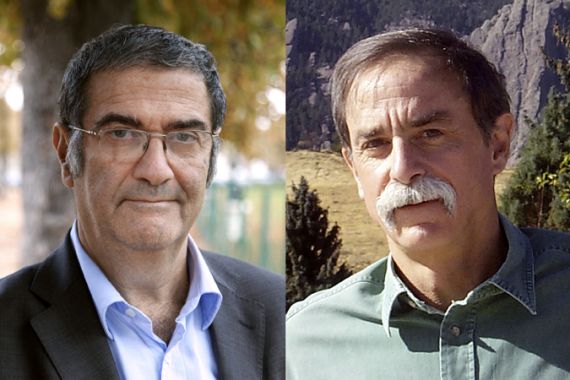Quantum computing researchers win Nobel
US and French scientists developed methods that allowed them to control fragile quantum states, winning physics prize.

Serge Haroche of France and David Wineland of the US will share the 2012 Nobel Prize in physics, and the $1.2m prize pot that goes with it, the Royal Swedish Academy of Sciences has announced.
The two have been given the award for their work on the interaction of light and matter.
Keep reading
list of 4 itemsHong Kong’s first monkey virus case – what do we know about the B virus?
Why will low birthrate in Europe trigger ‘Staggering social change’?
The Max Planck Society must end its unconditional support for Israel
The duo, who worked separately, have paved the way for experiments in the field of quantum physics, after showing how individual quantum particles may be observed without being destroyed – work which aims to resolve the uncertainty principle established by Werner Heisenberg, the 1932 Nobel Physics prize winner.
A quantum particle is one that is isolated from everything else. In this situation, an atom or electron or photon takes on strange properties.
It can be in two places at once, for example. In some ways, it can also behave as a wave, rather than matter. But these properties are instantly changed when it interacts with something else, such as when somebody observes it.
Haroche and Wineland, both 68, developed “ingenious laboratory methods” that allowed them to manage, measure and control fragile quantum states, the Royal Swedish Academy of Sciences said in its announcement on Tuesday.
“Their ground-breaking methods have enabled this field of research to take the very first steps towards building a new type of superfast computer based on quantum physics,” the Academy said in a statement.
“The research has also led to the construction of extremely precise clocks that could become the future basis for a new standard of time.”
Applications in computing
Researchers in quantum computing aim to reduce the size of computer processors to the molecular level, manipulating individual atoms to build arithmetic and logical functions that operate at speeds drastically beyond any processor or circuitry built from traditional semiconductors.
One popular example is that of a computer trying to work out the shortest route around town for a travelling salesman. A traditional computer might try every possible route and then choose the shortest. A quantum computer could do the calculation in one step, as if the salesman travelled each route simultaneously.
The Nobel committee said the prize-winning pair used opposite approaches to the same problem: Wineland uses light particles – or photons – to measure and control particles of matter – electrons – while Haroche uses electrons to control and measure photons.
In one of the strange properties of quantum mechanics, tiny particles act as if they are simultaneously in two locations, based on the likelihood that they would be found at either, known as a “superposition”.
It was long thought that it would be impossible to demonstrate this in a lab, a problem akin to “Schrodinger’s cat”.
Wineland’s “parlour trick”, as he called it, was to hit an atom with a laser, which according to quantum theory would have a 50 per cent chance of moving it, and observe the atom at two different locations, 80 billionths of a metre apart.
In a normal computer, a switch must either be on or off. A quantum computer would work with switches that, like the particles in Wineland’s experiment, could behave as if they were in more than one position at the same time.
‘Very overwhelming’
Haroche, of the College de France and Ecole Normale Superieure in Paris, said he was out walking with his wife when he got the call from the Nobel judges.
“I was in the street and passing a bench so I was able to sit down,” Haroche said by telephone. “It’s very overwhelming.
“First I called my children, then I called my closest colleagues, without whom I would never have won this prize.”
Asked how he would celebrate, he said: “I will have champagne, of course.”
The results of Haroche and Wineland’s work have realised the ambitions of quantum physicists around the world, said researchers.
“This year’s Nobel Prize recognises some of the most incredible experimental tests of the weirder aspects of quantum
mechanics,” Jim al-Khalili, professor of physics at the University of Surrey in Britain, said.
“Until the last decade or two, some of these results were nothing more than ideas in science fiction or, at best, the wilder imaginations of quantum physicists. Wineland and Haroche and their teams have shown just how strange the quantum world really is and opened up the potential for new technologies undreamt of not so long ago.”
The prizes will be officially awarded on December 10, the anniversary of the 1896 death of prize founder – and dynamite tycoon – Alfred Nobel.